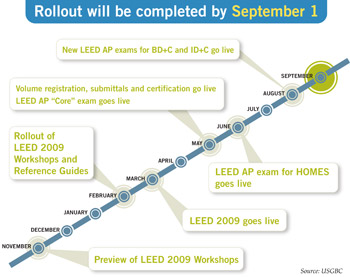| FEATURE ARTICLE, JANUARY 2009
LEED 2009
Omniplan’s Phillip Jones answers our questions about LEED 2009 and how it will affect future development in Texas.
The U.S. Green Building Council (USGBC) unveiled its long-awaited update to the LEED green building certification program late last fall. Called LEED 2009, the new rating system includes a “series of major technical advancements focused on improving energy efficiency, reducing carbon emissions, and addressing other environment and human health outcomes,” according to a USGBC press release from November 18, 2008. TREB recently spoke with Phillip Jones, LEED AP, associate principal with Omniplan in Dallas, to get his take on the updated program and how it will impact development going forward in Texas and the rest of the country.
TREB: What exactly are the changes that are being implemented in 2009 for LEED?
Jones: At the core of the changes is the objective to reduce the overlap between the programs of New Construction, Core and Shell, Commercial Interiors, Existing Buildings: Operations & Maintenance and Schools. Each one of them had similar components, but they were not exactly the same. It was a struggle for professionals to keep up with the nuances from one program to another. With LEED 2009, which is part of LEED Version 3, the USGBC is going to combine all of these components together.
TREB: What are some of the biggest advancements you believe will be shown through these changes?
Jones: To me, it’s not so much about the change as it is the clarity of the whole system. I just returned from the USGBC conference in Boston, and it was a great experience. I believe 33,000 design and engineering professionals attended. The LEED advancements from year to year are just wonderful, not only for our industry and our world, but for the USGBC itself, which has really matured. The organization is thinking clearly, recognizing that sustainability is a way of life and it needs to be something that can be broadly used and implemented. The USGBC has done a great job of merging all of these standards together.
TREB: How will these changes affect projects that have already been registered under the current LEED system?
Jones: There won’t be any impact on current projects, other than developers and design professionals will now have a choice. They can continue under the current program they are pursuing, or they can switch.
TREB: How do you foresee LEED 2009 affecting the future of development in Texas?
Jones: I can’t say that LEED 2009 is going to have an impact on future development, other than the fact that the changes recognize sustainability is a necessary part of our built environment. The USGBC is trying to make it an integral and relevant part of every building type that we pursue. Because of the system’s relative simplicity, it will make developers’ receptivity to LEED greater.
TREB: From your perspective, why do you believe LEED 2009 was introduced?
Jones: From what I learned at the USGBC conference, as well as my own assessment, it was introduced because the USGBC recognizes the necessary complexity of LEED as it matures. We began with Core and Shell and New Construction, and then added Commercial Interiors, then Existing Buildings: Operations and Maintenance and finally, Schools. Soon we will have LEED for retail, which is fabulous, and will fall under the same LEED 2009 program.
TREB: Is LEED 2009 being well received by the commercial real estate industry?
Jones: Yes. There was resounding receptivity at the conference. I attended one of the sessions focused on LEED 2009, and it was widely attended with great enthusiasm.
— Phillip Jones, LEED AP, is an associate principal with Omniplan in Dallas.
PLUS, from the USGBC...

TREB: Why did the USGBC decide to update the LEED system?
Katz: In order for LEED to continue to drive the marketplace further, it’s important for LEED to continue to undergo a process of continuous improvement, which will create a more flexible and adaptive program and allow USGBC to respond seamlessly to the market’s evolving needs. The next version of LEED is a culmination of volunteer time and expertise, and it truly resets the bar for how we certify higher performance in buildings.
TREB: How did the organization decide on these changes? Did the members get a say?
Katz: Yes, since LEED is consensus-base, all of our 17,800+ member companies have a voice and a hand in developing LEED 2009 and all certification systems. All certifications systems must be piloted and balloted with the full USGBC membership before they will be launched and implemented by USGBC. On Nov. 18, we announced that LEED 2009 passed member ballot and will be introduced in 2009.
TREB: How will professionals learn about the details of LEED 2009?
Katz: All of the changes will be introduced in February 2009 in our Reference Guides and reflected in our workshops. LEED 2009 will be officially available for use in March 2009. The whole rollout of all the various components of LEED 2009 will conclude in September.
— Ashley Katz is the communications coordinator for the USGBC. |
©2009 France Publications, Inc. Duplication
or reproduction of this article not permitted without authorization
from France Publications, Inc. For information on reprints of
this article contact Barbara
Sherer at (630) 554-6054.
|
